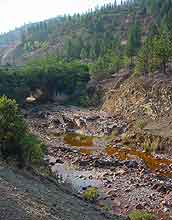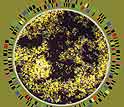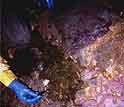|

Press Release 04-011
Microbial Biofilm Yields Community Genomes, Metabolic Clues

Research from Iron Mountain mine sheds light on acid drainage
February 1, 2004
ARLINGTON, Va.—Examining life extracted from toxic runoff at a northern California mine, researchers for the first time have reconstructed multiple individual genomes from a microbial community taken from an environmental sample rather than from a laboratory culture.
According to Jill Banfield, the leader of the scientific team behind the discovery, "This takes the study of natural biogeochemical systems to a new level."
Announced Feb. 1 in the online version of the journal Nature, the research focused on a sample from a postage-stamp-sized patch of pink biofilm taken from a thin microbial layer found growing hundreds of feet underground. (Often slimy, biofilms are communities of microorganisms—such as bacteria and fungi—that grow on surfaces. Think of a kitchen sink left unwiped.) The research team found its biofilm atop a hot, flowing, extremely acidic solution—laden with dissolved iron, copper, zinc and arsenic—emanating from a mine on Iron Mountain, about nine miles northwest of Redding.
According to the Environmental Protection Agency, the mine, which shut down in 1963 after nearly a century of operations, created the most acidic mine drainage in the world, discharging—on average—a ton of toxic metals every day into the Upper Sacramento River until remediation efforts began a decade ago.
Acid mine drainage remains a significant environmental problem worldwide. Banfield, a professor at the University of California at Berkeley, said the new findings enhance scientists' understanding of the metabolic activity of iron-oxidizing microbes that greatly accelerates acid production.
Nine other scientists from Berkeley and the Department of Energy's Joint Genome Institute in Walnut Creek, Calif., co-authored the report. The study was funded by the National Science Foundation's Biocomplexity in the Environment program and the Department of Energy's Microbial Genomics Program.
According to Matt Kane, program director in NSF's Division of Molecular and Cellular Biosciences, the findings shed light on how bacteria and other microbes function collectively.
"This work simultaneously reconstructed the genome sequences for a five-membered microbial community from nature," Kane said. "It goes beyond previous achievements, such as those that sequenced the entire genome of single, isolated species or efforts that gathered genomic content from a microbial community but stopped short of constructing the individual genomes within it."
The researchers first screened several biofilms with a technique called FISH—fluorescence in situ hybridization—before settling on the particular pink sample a soup of several strains typical of acid mine drainages. They then applied to their selected community a genomics approach usually put to an individual species—"random shotgun sequencing."
This meant extracting DNA directly from the sample and a "small insert library."
Once the sequences of short pieces of DNA were obtained, computer processing linked them to generate large genomic fragments that could be assigned to specific organisms within the community.
The researchers reconstructed nearly complete genomes of two organisms—strains of the bacterium Leptospirillum and of the archaeon Ferroplasma—and partial genomes of three other microbes. According to the researchers' Nature article, such recovery "from an environmental sample is an advance in the study of natural microbial communities."
According to Banfield, "The transition to this genome-level study of real populations opens the way for new understanding of speciation and evolution."
Further analysis of each organism's gene complement yielded clues about which microbes are most likely responsible for which services in this acid-adapted, self-sustaining community.
For example, organic compounds produced by the community allow it to attach to its surroundings; float at the air-water interface; and make readily accessible the oxygen, carbon dioxide, nitrogen and iron necessary for respiration and metabolism.
While researchers are unsure which organisms are responsible for creating some key polymers, they found within the Leptospirillum strain—but not in the Ferroplasma strain—the genes for making cellulose and other proteins that prevent drying out and support floatation. The genetic foundation of other critical functions, such as making carbon and nitrogen accessible to the organisms, also appears to be "partitioned among members of the community," Banfield said.
-NSF-
Background resources:
"NSF Awards $31.9 Million in Grants to Study Biocomplexity in the Environment," news release, October 14, 2003: "To better understand the interrelationships among living things from molecular structures to genes to ecosystems—and how they interact with their environment—the National Science Foundation (NSF) has awarded $31.9 million in 30 research grants to scientists and engineers across the country...."
http://www.nsf.gov/od/lpa/news/03/pr03116.htm
"Biocomplexity in the Environment," NSF fact sheet, October 2003:
http://www.nsf.gov/od/lpa/news/03/fs03_biocomplexity.htm
"BE/GEN-EN: Analysis of Factors Determining the Ecological Function and
Resilience of Microbial Communities," abstract of relevant NSF grant:
https://www.fastlane.nsf.gov/servlet/showaward?award=0221768
Genome-Enabled Environmental Sciences and Engineering (GEN-EN) (from 2003 NSF program solicitation "Biocomplexity in the Environment: Integrated Research and Education in Environmental Systems): "The GEN-EN topical area invites the submission of proposals which use scientific and/or engineering approaches to develop and apply genomic information and tools to further our understanding of how organisms interact with (adjust to and modify) their environment...."
http://www.nsf.gov/pubs/2003/nsf03597/nsf03597.htm#genen
Genomes and acid mine drainage, research by geomicrobiology group at UC Berkeley: Microbes impact their environments and microbial communities are shaped by the geochemistry of their surroundings. This connection is especially clear in the case of extremely acidophilic microorganisms that live in association with weathering metal sulfide deposits.
http://www.seismo.berkeley.edu/~jill/amd/AMDresearch.html
DOE's Joint Genome Institute: Established in 1997 by three Department of Energy national laboratories, it supports genome-sequencing projects that include microbes, vertebrates, fungi and plants.
www.jgi.doe.gov
Iron Mountain toxic releases, cleanup settlement (Environmental Protection Agency news release-October 19, 2000): The settlement will ensure long-term control of more than 95 percent of the releases from Iron Mountain, historically the largest point source of toxic metals in the country, and the source of the most acidic mine drainage in the world.
http://www.epa.gov/region09/features/ironmountain.html

Media Contacts
Sean Kearns, NSF (703) 292-7963 skearns@nsf.gov
Program Contacts
Matt Kane, NSF (703) 292-7186 mkane@nsf.gov
Principal Investigators
Jill Banfield, University of California-Berkeley (510) 642-9488 jill@seismo.berkeley.edu
Related Websites
Professor Jill Banfield's Website: http://www.seismo.berkeley.edu/~jill/amd/AMDresearch.html

The National Science Foundation (NSF) is an independent federal agency that supports fundamental research and education across all fields of science and engineering. In fiscal year (FY) 2009, its budget is $9.5 billion, which includes $3.0 billion provided through the American Recovery and Reinvestment Act. NSF funds reach all 50 states through grants to over 1,900 universities and institutions. Each year, NSF receives about 44,400 competitive requests for funding, and makes over 11,500 new funding awards. NSF also awards over $400 million in professional and service contracts yearly.
 Get News Updates by Email Get News Updates by Email
Useful NSF Web Sites:
NSF Home Page: http://www.nsf.gov
NSF News: http://www.nsf.gov/news/
For the News Media: http://www.nsf.gov/news/newsroom.jsp
Science and Engineering Statistics: http://www.nsf.gov/statistics/
Awards Searches: http://www.nsf.gov/awardsearch/
| 




